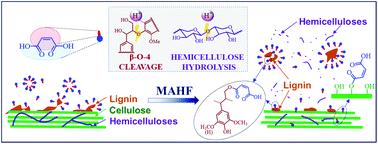Maleic acid as a dicarboxylic acid hydrotrope for sustainable fractionation of wood at atmospheric pressure and ≤100 °C: mode and utility of lignin esterification†
Abstract
This study evaluated maleic acid (MA) as a green hydrotrope for efficient wood fractionation at atmospheric pressure and ≤100 °C. MA hydrotropic fractionation (MAHF) resulted in esterified lignin with a low degree of condensation and a very light color. 2D 1H–13C HSQC and HMBC NMR analyses of reaction products of a lignin model compound guaiacylglycerol-beta-guaiacyl ether with MA identified bonding through the γ-OH group. The surface charge of lignocellulosic MAHF water insoluble solids (WIS), induced by lignin esterification (carboxylation), enhanced enzymatic sugar yield by reducing nonproductive cellulase binding to lignin through pH-mediated electrostatic repulsion and also enhanced the lubrication effect of lignin in mechanical nanofibrillation for producing cellulose nanofibrils from WIS. Preliminary studies indicated that disssolved xylan can be dehydrated into furfural by MA in the fractionated liquor at a good yield of 70% and MA can be reused for repeated fractionation with minimal loss of less than 5%.



 Please wait while we load your content...
Please wait while we load your content...